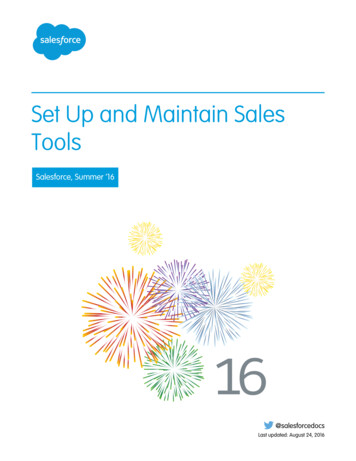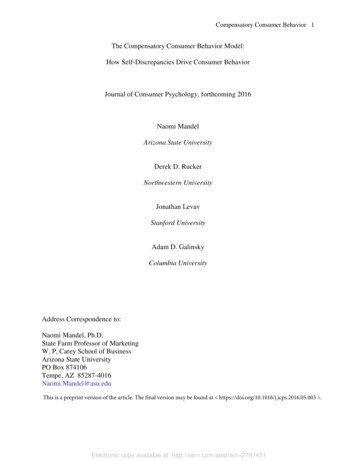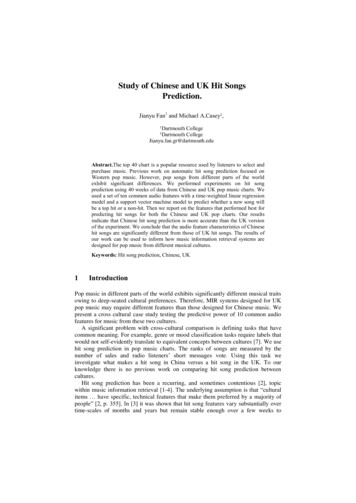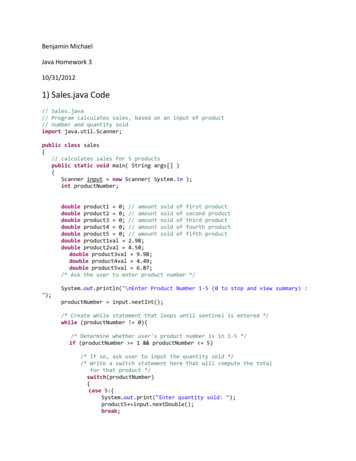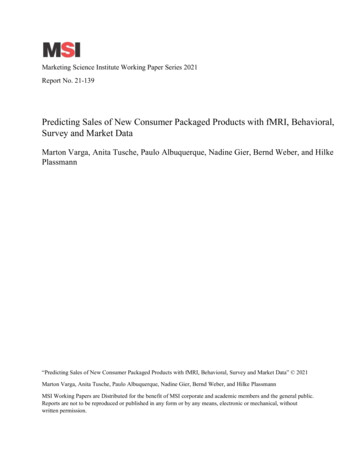
Transcription
Marketing Science Institute Working Paper Series 2021Report No. 21-139Predicting Sales of New Consumer Packaged Products with fMRI, Behavioral,Survey and Market DataMarton Varga, Anita Tusche, Paulo Albuquerque, Nadine Gier, Bernd Weber, and HilkePlassmann“Predicting Sales of New Consumer Packaged Products with fMRI, Behavioral, Survey and Market Data” 2021Marton Varga, Anita Tusche, Paulo Albuquerque, Nadine Gier, Bernd Weber, and Hilke PlassmannMSI Working Papers are Distributed for the benefit of MSI corporate and academic members and the general public.Reports are not to be reproduced or published in any form or by any means, electronic or mechanical, withoutwritten permission.
PREDICTING SALES OF NEW CONSUMER PACKAGED PRODUCTSWITH fMRI, BEHAVIORAL, SURVEY, AND MARKET DATAMarton Varga1Anita Tusche2Paulo Albuquerque1*Nadine Gier3Bernd Weber4Hilke Plassmann1*1INSEAD, FranceQueen’s University, Canada3Heinrich Heine University, Dusseldorf, Germany4Rheinische Friedrich-Wilhelms-University of Bonn, Germany* Corresponding authors2Abstract: This paper studied the relevance of different types of data for a retailer’s ability to predictsales of new products before their launch. Our approach combined four information sources: (1)in-house observable market data such as price and promotion level, (2) customer attitudes basedon a representative survey, (3) incentivized purchasing decisions, and (4) functional magneticresonance imaging (fMRI) data from a relatively small sample of individuals collected in alaboratory. We used a large German retailer’s weekly sales data to define an estimation data setcontaining 34 packaged foods and drinks. This estimation data set was used to estimate theparameters of our model. We then used the parameter estimates to predict sales of 17 differentproducts before they were launched. Results indicate that using fMRI data to forecast sales of newproducts significantly increased forecasting accuracy: It led to a 28.6% better forecast than a naïvemodel that considered historic sales data only, while the model combining all data led to animprovement of 38.6%. Using our approach, managers can quantify the benefits of collectingdifferent types of data beyond observable market data—including neuroscientific data—to predictthe market success of new products.Acknowledgments: We acknowledge funding from INSEAD’s Octapharma Chair awarded to HPand would like to thank Peter Kenning for developing a pilot study and sharing its data for thisproject.Marketing Science Institute Working Paper Series1
INTRODUCTIONOne of the key decisions of marketing managers is whether to launch a new product (Beard& Easingwood, 1996; Biyalogorsky, Boulding, & Staelin, 2006) to maintain or grow market shareor to conquer new markets (Hultink et al., 2000). The launch of a new product depends onsignificant amounts of resources allocated to that initiative before and during the launch(Bhaskaran & Krishnan, 2009). It involves a broad range of firm decisions, such as promotionsand pricing on the marketing side, and capacity planning, production, and inventory scheduling onthe supply chain side (Cooper, 1979; Petersen, Handfield, & Ragatz, 2005). For example, in 2006the French company Danone spent over 10 million introducing the new yogurt brand Essensis,which later failed and was removed from the market (Bruno & Plassmann, 2014). About 40% ofnew products fail at launch, even after extensive evaluation, and only one out of 10 innovationsachieves commercial success (Cooper, 2011; Cooper, Edgett, & Kleinschmidt, 2004). Thus,correctly predicting the success of new products is crucial and of great interest to firms (Cooper,1979; Cooper & Kleinschmidt, 1987, 1995; Rothwell, 1974; Rothwell et al., 1974; Ryans, 1988).Given this importance, there is a continuous search for new methods and informationsources that can improve the accuracy of forecasts of commercial success (Kahn & Chase, 2018).Compelling work in consumer neuroscience has shown that neuroscientific data, such as functionalmagnetic resonance imaging (fMRI) and electroencephalography (EEG) variables, can predictmarket-level outcomes such as music sales (Berns & Moore, 2012), movie box office sales(Boksem & Smidts, 2015), and advertising elasticities (Venkatraman et al., 2015). These findingssuggest that neuroscientific data from a few participants might outperform traditional marketingresearch measures such as attitudes and preferences (Knutson & Genevsky, 2018).Marketing Science Institute Working Paper Series2
The main objective of this paper is to investigate the contribution of fMRI data incombination with other data types that marketers typically use to predict sales of new products.With the collaboration of a large German food retailer, we obtained weekly sales and market data(including prices and promotional activities) for 56 different food and beverage items. We alsoused surveys to collect information about consumer attitudes toward these products from arepresentative set of customers of the retailer. Finally, we conducted a brain imaging study tocollect fMRI data and non-hypothetical, incentive-compatible purchase decisions regarding theseproducts. Here, a small number of customers not representative of the retailer’s customer basewere exposed to images of the product and price information and indicated their incentivizedwillingness to buy. This setup allowed us to measure the impact of each of the four data types wecollected (market, survey, incentivized purchase behavior, and fMRI data), on its own or incombination with the other data, on the prediction of sales of new products above and beyond ourbaseline model, which used average weekly historical sales data.After data cleaning (excluding 5 out of the 56 products), our sample of products wasdivided into an estimation data set (34 products) and a prediction data set (17 products). Weassessed the change in forecast accuracy of our models in terms of the mean average percentageerror (MAPE). Using regression models,1 our results show that using fMRI data led to animprovement of 28.6% in prediction accuracy compared to a naïve model that considered only theaverage sales of old products to forecast new product performance. When considered in isolationas the only information source, the fMRI variables did better than models that considered the otheravailable data types (i.e., market data, surveys, and incentive-compatible purchase decisions) ontheir own. When all data were combined, the improvement in prediction accuracy reached 38.6%1We also implemented random forest models, with substantively similar results. We discuss them in the resultssection.Marketing Science Institute Working Paper Series3
compared to the naïve model. Model predictions and additional information about the costs ofcollecting each data type provide insights into the value of each source of information for the firm.Taken together, our results can assist managers in justifying the acquisition of the different datatypes to improve forecasts. This is especially important for fMRI data, with which managers arelikely to have less experience and thus less knowledge of costs and return on investment.LITERATURE REVIEWOur paper is related to two streams of past work: (1) the contribution of brain imaging datato predict consumer choices and (2) the prediction of the performance of new products through theuse of different types of data. In what follows, we summarize previous work in these two streams.Market-level predictions using brain imaging dataOne promise of the nascent field of consumer neuroscience has been to improve predictions aboutwhat consumers like and thus decide to buy (Plassmann et al., 2015). Being able to more accuratelypredict whether consumers will buy a product has important marketing applications for newproduct development (Ariely & Berns, 2010). Table 1 presents an overview.In a seminal paper, Knutson et al., (2007) developed an fMRI purchasing task in whichparticipants evaluated the desirability of consumer products, considered whether they were worththe price, and decided to buy or not (see supplemental Figure S1). Brain responses obtained in thistask improved the prediction of the sample’s purchase decisions above and beyond self-reportedliking of these products, albeit only marginally. The authors identified three brain regions that werepredictive of purchasing decisions: (1) the ventral striatum (vStr), (2) the ventromedial prefrontalcortex (vmPFC), and (3) the anterior insula (aI). Evidence on the ability of these brain regions topredict consumer preferences and choices has been replicated and extended across studies andMarketing Science Institute Working Paper Series4
various product categories (Genevsky & Knutson, 2015; Tong et al., 2020; Tusche, Bode, &Haynes, 2010). Our selection of brain regions from which to extract fMRI data was based on thisevidence, as detailed in the methods section.These initial empirical findings showcase the consistency of brain regions involved inpurchasing decisions on the level of single individuals. More recent papers (summarized in Table1) have demonstrated the ability of neuroscientific data to predict out-of-sample behavior at themarket level—a new method commonly referred to as neuroforecasting (Knutson & Genevsky,2018). Berns & Moore (2012) provided early evidence in favor of neural predictions of marketlevel outcomes. They found that brain imaging data from a few music listeners (N 27) couldpredict whether a song would become a national hit three years later, as indicated by commercialsales data from Nielsen SoundScan. Data from brain activity in the vStr—obtained using fMRIwhile subjects listened to music—were successfully used to predict the future sales of those songs,while self-reported liking ratings taken at the fMRI experiment showed no significant correlationwith future sales. This study was the first to suggest that brain data from a relatively small sampleof individuals could predict commercial sales at the market level better than self-reported likingratings.Marketing Science Institute Working Paper Series5
Table 1: Summary of neuroforecasting literatureDataBerns & Moore (2012)Falk, Berkman, &Lieberman (2012)Before launchsurvey N 27,fMRI N 27listening to 120unknown songssurvey N 30,fMRI N 30watching threeanti-smokingannouncementsDmochowski et al.(2014)Boksem & Smidts(2015)Genevsky & Knutson(2015)Venkatraman et al.(2015)Falk et al., (2016)Kühn, Strelow, &Gallinat (2016)Barnett & Cerf (2017)Genevsky, Yoon, &Knutson (2017)Scholz et al. (2017)Cha et al. (2019)Shestyuk et al. (2019)Motoki et al. (2020)Tong et al. (2020)survey N 36 &N 19 fromMTurk, fMRIN 47fMRI N 18,seeing sixchocolate adssurvey N 122,mobile EEG ISC,N 58 and SCR,13 movie trailerssurvey N 30 35, fMRI N 30 35survey 41, fMRIN 41 & N 39PredictionMeasuresAfter launchNielsen SoundScan for 87songsVariablesnumber of albums soldcontaining that song, threeyears laterEvaluate data/modelsself-reported liking ratingand fMRI measures ofsame participantscall volume to 1-800-QUITNOWad effectiveness difference incall volume before and afterPSA launchself-reported liking and adeffectiveness rating andfMRI measures of sameparticipantsweighted Kendall’s taumoderation analysisStudy 1: EEG ISC, N 16while seeing scenes from TVshow tweet volume andaudience size, study 2: EEGISC N 12 Superbowl ads,survey N 12, likingsurvey N 29, EEG beta andgamma oscillations N 29while watching trailers of 18never seen movies, U.S. boxoffice movie salessurvey N 28, fMRI N 28while doing a microlendingtask, internet lending ratestime-stamped tweet volumefrom Crimson Hexagon andNielsen’s audience size whileTV show was nationally airedand Facebook-USA Today AdMeter liking of adsU.S. box office movie salesself-reported ad liking andEEG ISC for study 2explained varianceself-reported liking,ranking, WTP of movies,EEG gamma bandexplained varianceinternet lending rates forrequests from kiva.comexplained variance,AIC, classificationaccuracysurvey N 186, IAT N 80,eye-tracking, heart rate, andSCR N 29, fMRI N 33while viewing ads and adelasticityclick-through rate citywideanti-smoking email campaignad elasticity for 37 adsself-reported affect,lending choices, and fMRImeasures of sameparticipantsIAT N 80, eye-tracking,heart rate, and SCR N 29,fMRI N 33 whileviewing ads above andbeyond the survey dataself-reported affect, imagestrength and adeffectiveness rating, andfMRI measurescompared contribution ofdifferent brain regionsself-reported WTP, likingand free recall, and ISCEEG measuresdiscussion ofcoefficientsself-reported affect,success, funding choices,and fMRI measures ofsame participantsself-reported intention toshare and fMRI measuresof same participantsneural measures withfNIRSexplained variance,AIC, classificationaccuracycorrelation betweentwitter activity andaudience size vs. EEGcomponentsself-report and neuralmeasureschoices, self-reportedaffect ratings and fMRImeasures in the sameparticipantsexplained variancedaily sales of advertisedproduct for six weeks, addisplayed at POSU.S. box office movie salesdaily sales for one week in onesupermarket that used each adat the point of saleaverage weekly movie ticketsalesmarket-level crowdfundingoutcomes)crowdfunding decisions onkickstarter.comonline sharing of news articlecaptured by NYTimes APIonline sharing via Facebookand Twitter of news articlefNIRS N 56, averagenumber of daily hits onYouTubeEEG measures, N 38 whileseeing scenes from a TVshow, tweet volume andaudience sizesurvey N 40, fMRI N 40survey N 36, fMRI N 36,YouTube video viewfrequency and durationtweet volume and audience sizeduring first airing of TV showbased on Nielsensharing ads in social mediametadata extracted frominternet: aggregate viewfrequency and aggregate videoengagementexplained varianceexplained variancediscussion ofcoefficientsexplained variancediscussion ofcoefficientsAIC, MSEexplained variance,AIC, RMSE,classification accuracyNotes: ISC Inter-subject correlations, fMRI functional magnetic resonance imaging, EEG electroencephalography, SCR skin conductance response, IAT implicit association test, fNIRS functionalnear-infrared spectroscopyMarketing Science Institute Working Paper Series6
A related pioneering fMRI paper asked smokers who intended to quit (N 30) about theirliking and perceived effectiveness of three different anti-smoking campaigns after their brainswere scanned while watching them repeatedly (Falk, Berkman, & Lieberman, 2012). Neuralactivity in the vmPFC predicted the overall success of the three campaigns, measured in callvolume of the advertised quit hotline. Behavioral rankings from the same participants made lessaccurate predictions.The efficacy of brain data for forecasting market-level outcomes extends beyond fMRIdata. For instance, several papers demonstrated that brain activity measured using EEG predictedmarket-level outcomes such as U.S. box office sales (Barnett & Cerf, 2017; Boksem & Smidts,2015) and TV audience size (Dmochowski et al., 2014), above and beyond self-reported liking andrelated preference measures. These studies used a greater variety of methodological approachesand metrics to capture people’s brain activity in response to the marketing stimuli, such as differentoscillation bands, different components of time-locked EEG signals, and how much participants’brains had the same reaction (using correlations between participants’ EEG signals). Thus, lessconsistency exists regarding the type of EEG signal best suited for which type of neuroforecastingexercise (see Hakim & Levy, 2019) for a review).The idea that “brain beats behavior” in predicting market-level success has since beenconceptually replicated and generalized across product categories—examples include forecastingthe success of microloan appeals (Genevsky & Knutson, 2015), advertising elasticities(Venkatraman et al., 2015), movie sales (Boksem & Smidts, 2015), chocolate sales (Kühn,Strelow, & Gallinat, 2016), news article popularity (Scholz et al., 2017), crowdfunding appealsuccess (Genevsky, Yoon, & Knutson, 2017), and YouTube viewing frequency and duration (TongMarketing Science Institute Working Paper Series7
et al., 2020)—and also across different brain imaging techniques (for a review see Knutson &Genevsky, 2018).All these studies compare different data types from a few individuals in a laboratoryenvironment with their brain imaging data (except Venkatraman et al., 2015). To advance theneuroforecasting literature and demonstrate the value of consumer neuroscience for marketingmanagers and neuromarketing companies, the comparisons need to include richer data sets thatcompanies typically have access to or acquire to predict sales and success. Against thisbackground, this paper investigates whether the combination of different data types can predictsales of newly introduced food and beverage products. These data sources are (1) market data suchas price and promotion level that are accessible for retailers and manufacturers, (2) representativesurveys asking customers about their attitudes and intentions, (3) incentivized purchasingdecisions, and (4) functional magnetic resonance imaging (fMRI) data from a relatively smallsample of individuals collected in a laboratory. Figure 1 gives an overview of the generalmethodological approach underlying this paper.Figure 1: Overview Methodological ApproachMarketing Science Institute Working Paper Series8
Combining different data sets to predict the performance of new productsIn marketing, work on new product performance began by using data from initial sales ofa launched product to predict whether that product was going to be successful in the long run,mostly drawing from repeat-purchase patterns and loyalty rates (Fourt & Woodlock, 1960). Earlypapers on new product performance prediction reported that sales of fast-moving consumer goodswere easier to predict than those of other product categories, due to the repetition of purchasedecisions. In parallel, Bass (1969) established that the consumer's initial purchase decision is afunction of the number of previous buyers of the product, and since his seminal work, papers usingdiffusion models to study the success of new products have become commonplace in the marketingliterature (e.g., Chandrasekaran & Tellis, 2017; Fan, Che, & Chen, 2017). Given the focus of ourresearch question, we next discuss a subset of the subsequent literature on prediction ofperformance of new products, concentrating our attention on papers that examined how differenttypes of data can be used or combined to improve the accuracy of predictions of new product sales.Given that more data—in terms of both quantity and variety—have become increasinglyavailable and at a faster pace, researchers have made efforts to answer the question of how tocombine alternative data types and sources in a managerially relevant way. Kahn (2002) suggestedthat surveys, expert opinions, and average sales of comparable products are the most widespreadtechniques for predicting demand of new products, highlighting that these methods are populardue to their interpretability. As Armstrong, Green, & Graefe (2015) argued, practitioners shouldbe overly conservative when they do not understand the forecasting procedures. Our aim is toprovide a parsimonious method of combining different data, with the intent of investigating whichdata set or data sets can best improve the prediction of sales of new products.Marketing Science Institute Working Paper Series9
The objective of combining data is to make use of the advantages of each data type whilereducing the disadvantages. Phaneuf, Taylor, & Braden (2013) provided a review of how data onrevealed preferences and stated preferences have been combined in marketing, transportation, andenvironmental economics literature with this purpose in mind. While the main advantage(disadvantage) of revealed preferences data is that it is based on real choices (it is historic innature), the main advantage (disadvantage) of stated preferences data is that it is flexible inscenario creation (it is hypothetical in nature). Morikawa, Ben-Akiva, & McFadden (2002) alsohighlighted this and the fact that the two types of data have complementary characteristics andproposed a methodology to use multiple types of data to estimate discrete choice models. Thecombination of the different data sets allows for a better prediction of scenarios, such as newproduct introduction (Phaneuf, Taylor, & Braden, 2013), that go beyond the scope of the revealedpreferences data, in our case previous sales and price data, and consider possible trends orbehavioral perspectives from survey participants.Several papers have tackled similar research questions. In their seminal paper, Rossi,McCulloch, & Allenby (1996) combined data on past choices, causal variables (such as price,display, and feature), and demographics to better predict individual price and promotionalelasticities, which is essential information for targeting marketing activities. The authors showedthat previous choices are very informative about consumer preferences. Urban, Weinberg, &Hauser (1996) described how pre-market forecasting can be done for automobiles, using methodswith a multimedia virtual-buying environment (an experiment with about 600 participants) tosimulate a user experience, combined with tasks where consumers could seek more informationabout the product, surveys about their purchase intent, and the use of diffusion models and conjointanalysis. The authors quantified the value of each type of data by comparing implementation costsMarketing Science Institute Working Paper Series10
with benefits regarding the final launch decision of the product. We use a similar approach: thecollection and implementation of several studies that allow us to obtain data, which is then used topredict the success of new products.Feit, Beltramo, & Feinberg (2010) combined different data sets to better predict marketshares of products with different levels of attributes. The authors argued that estimates of theimportance of product attributes that rely solely on hypothetical choice experiments (for example,conjoint analysis) frequently show inconsistencies that can and should be corrected through thecombination of these data with individual-level purchase data. The authors applied a generalframework using Bayesian models and individual-level data to the evaluation of attributes in theU.S. minivan market, predicting holdout purchases better than an approach that excludedindividual characteristics and motivations.The data used in some papers goes beyond the traditional revealed and stated preferencesdata. For example, Mueller et al. (2010), in a two-stage approach, applied an online discrete choiceexperiment combined with product consumption tasks to understand the interplay between sensory(e.g., taste) and product (e.g., packaging) characteristics to predict liking and repurchase intentionof Australian red wines. The study was designed in such a way as to integrate the entire purchaseprocess, from the initial choice through the consumption process and the repurchase decision, withthe intent of predicting repurchase decisions. The authors found that data on both types ofcharacteristics are important in explaining repurchase decisions, although the findings in terms ofthe combination of the data seem to have limited suitability to find the drivers of purchasedecisions, in part because wine might be too complex a product for consumers to base theirrepurchase intention on taste (Mueller et al., 2010). Schneider & Gupta (2016) used both numericMarketing Science Institute Working Paper Series11
and textual data from consumer reviews to predict the sales of existing and new products, using aparsimonious linear regression approach, in a similar way as our proposed approach.Beyond marketing, other fields such as healthcare have also benefited from similarmethods. For example, Harris & Keane (1998) studied elderly consumers’ choice among healthplans using attitudinal data and choice data, showing that the combination of these data setsprovided more reliable estimates of their preferences for and perceptions of the attributes of choicealternatives. Kappe, Venkataraman, & Stremersch, (2017) combined historic data on prescriptionsand firm detailing efforts with data from subject-matter experts obtained through a conjointexperiment to predict how firms would react to unprecedented detailing changes in thepharmaceutical industry.To summarize, motivated by these papers we collected data from several informationsources, estimated a parsimonious model that allowed us to predict sales and do a hold-outprediction evaluation, and conducted a cost-benefit analysis of each type of data, providing insightsto managers regarding which studies might be relevant.We finish the discussion of the literature on prediction by highlighting that there arealternative methods for prediction and measures to evaluate the accuracy of predictions. In termsof modeling approaches and their applicability to forecasting sales of new products, Hardie, Fader,& Wisniewski (1998) found that simple models provide significantly better forecasts than complexmodel specifications. Although there have been recent attempts to predict sales of new productswith complex approaches (Chong, Han, & Park, 2017; Kulkarni et al., 2012), Lee et al. (2012)showed that the simple logistic regression model is often a better choice than the more complexneural network approaches for forecasting the sales of fresh foods. Hence, and in line with otherpapers that use neuroscience data, we use linear regressions as the main method.Marketing Science Institute Working Paper Series12
For the measures used to evaluate prediction, we followed Hardie, Fader, & Wisniewski(1998) and used the mean absolute percentage error (MAPE) as main criterion, defined as𝑀𝐴𝑃𝐸 4 23 1,23()𝑌 , 𝑌. , /0𝑌 , (𝐽𝑇,where J is the number of products, T is the number of time periods (weeks), 𝑌 , is the value ofactual sales per retailer of product j in week t, and 𝑌. , is the respective estimated value. In Hardie,Fader, & Wisniewski (1998), the authors discussed which measure of prediction accuracy is bestsuited to product sales forecasting tasks and concluded that MAPE is recommended (see alsoMakridakis, 1993). Divakar, Ratchford, & Shankar (2005) also used MAPE as measure of forecastaccuracy in their paper on the practical applications of forecasting models. The authors highlightedthat a careful balance between modeling sophistication and practical relevance is key to achievingaccurate predictions, with MAPE being one of the easiest measures to understand and interpret. Inaddition, MAPE has been proven to be very appropriate in planning and budgeting situations(Makridakis, 1993). A number of recent applications have used MAPE, including Prayudani et al.(2019), Jadhav, Chinnappa Reddy, & Gaddi (2017), ArunKumar et al. (2021), Kaewtapee et al.(2021), and Wickramasinghe et al. (2021).SETTING AND DATA DESCRIPTIONOne of Germany’s largest food retailers provided us with data on 56 products (23 beveragesand 33 food items). Product selection by the retailer’s marketing managers ensured representationacross 18 product categories (e.g., canned tuna, carbonated soft drinks; on average three productseach) and sufficient variation in launch dates.Marketing Science Institute Working Paper Series13
For each product, we observed the average weekly number of units sold per retailer andthe number of retailers that decided to carry each product. For products launched before January2014, this data covered close to six years (until September 2019). For products launched afterJanuary 2014, we observed weekly sales and number of adopted retailers since their launch date.Figure 2 shows the sales evolution of three products in four product categories, as an illustration.It highlights the significant variation in the level of sales, even within each category, suggestingthat historical sales data for previously introduced products are limited in their predictiveusefulness for the sales of newly launched products. High variance in sales performancecharacterizes most categories in our data set and partly motivates the retailer’s managers to usemultiple data sets to predict sales.Figure 2: Evolution of product sales in four product categoriesMarketing Science Institute Working Paper Series14
We divided the products into two sets to implement our analysis approach and evaluate thepredictive utility in new product sets. Products launched before November 2016 (35 products)were part of an estimation set, while products launched after November 2016 were the predictionor test set (21 products; see Table S1 in the online appendix for products and launch dates). Thethreshold date was chosen for practical and data analytical reasons, as the retailer introducedseveral products soon after this date. Moreover, it yielded estimation and prediction sets of a sizeconsistent with standards for cross-validation and out-of-sample predictions in the field (Berrar,2019). In a way, adopting a threshold date mimics a manager’s challenge to forecast thecommercial success of not-yet-launched products, using the information on overall sales ofproducts in the food and drinks categories—and additional data sources at her disposal—at thispoint.Besides sales information, four different types of data formed our explanatory variables:(1) market data of all products, including prices and promotional activities; (2) attitudes towardthe products obtained using a survey from an online sample representative of the general customerpopulation of the supermarket chain (N 1451); (3) the incentive-compatible purchase decisionsof laboratory student participants while their brain responses were measured using fMRI (N 44);and (4) their neural correlates
Marketing Science Institute Working Paper Series 2021 Report No. 21-139. Predicting Sales of New Consumer Packaged Products with fMRI, Behavioral, Survey and Market Data. Marton Varga, Anita Tusche, Paulo A


